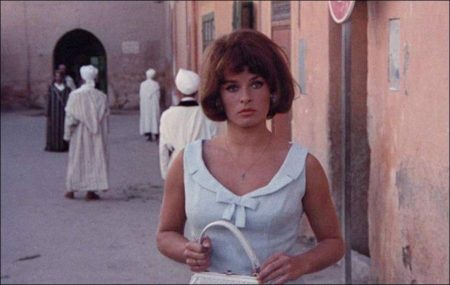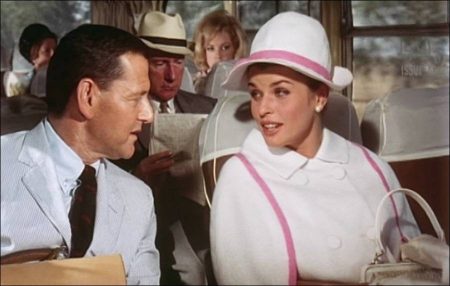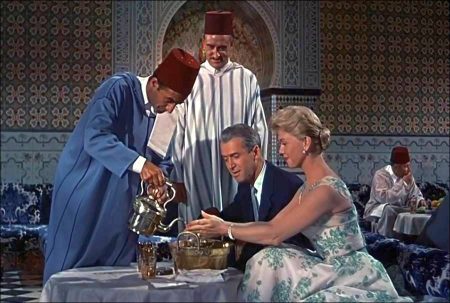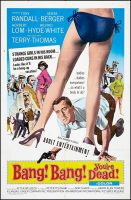Taglines: Bodies, bodies everywhere! So what’s a body to do?
Our Man in Marrakesh movie synopsis. One of six travellers who catch the bus from Casablanca airport to Marrakesh is carrying $2 million to pay a powerful local man (Herbert Lom) to fix United Nations votes on behalf of an unnamed nation. But not even the powerful man knows which of them it is – and his background checks reveal that at least three of them aren’t who they claim to be. As agents from other nations may be among them, he and his henchmen have to be very careful until the courier chooses to reveal himself – or herself…
Our Man in Marrakesh (released in North America as Bang! Bang! You’re Dead!) is a 1966 British comedy spy film shot in Morocco produced and co-written by Harry Alan Towers, directed by Don Sharp and starring Tony Randall, Senta Berger, Herbert Lom, Wilfrid Hyde-White, Terry-Thomas, Grégoire Aslan, John Le Mesurier, Klaus Kinski, Margaret Lee, Emile Stemmler and Helen Sanguinetti.
Our Man in Marrakesh opened in London on May 5, 1966, the same day as A Man Could Get Killed and the day before Modesty Blaise. This caused the critic in The Times to write a combined review titled “Humorous variations on theme of the secret agent”, where Our Man in Marrakesh is noted for having a story similar to A Man Could Get Killed, but comparatively lacking in wit. However, the film gets some credit for a colourful chase through Marrakesh’s dyers’ quarter.

Film Review for Our Man in Marrakesh
When American Andrew Jessel (Tony Randall arrives in Marrakesh on a business trip, he checks into the hotel and discovers a corpse in his wardrobe. This is the beginning of a “wrong man” style adventure involving international espionage and criminal gangs, but thankfully on his side is sexy super-spy Kyra Stanovy (Senta Berger).
The two set off to clear his name and solve the mystery, and spend large parts of the film having to rescue each other from assorted dangers, mainly involving local kingpin Casimir (Herbert Lom) and his psychotic henchman Jonquil (Klaus Kinski). Also thrown into the mix are British character actors Wilfrid Hyde-White, John Le Mesurier and Terry-Thomas, providing a combination of plot exposition and comic relief, and the entire plot builds to an inevitably happy conclusion where wrongs are made right, the guilty are punished and the innocent get to ride off into the sunset.
Our Man in Marrakesh (known in the States as Bang! Bang! You’re Dead!) is a typical mid-Sixties Harry Alan Towers production. An independent British producer who had made a name for himself in radio and television before moving into feature films, he specialised in European co-productions, pulling in A-list names and finance from several different countries.
His budgets were low, and his scripts were often second-rate, but he seemed to have a no trouble persuading bankable stars to take off around the world with him. He always preferred to shoot on location, and Our Man in Marrakesh is no exception. Aside from some rear-projection driving shots in a studio, most of the film is shot in Marrakesh itself, giving it a seedy authenticity which gives puts it on a par with the Bond films of the time.
This film was one of hundreds of Bond-style films produced during the 1960s. They became known as Eurospy films, although other countries and continents got in on the act, too. Our Man in Marrakesh mixes elements of Bond with Hitchcock’s thrillers fairly successfully, and Tony Randall makes a likeable comedic leading man. More fun, however, are the various characters that rotate around him, most notably Klaus Kinski, who once again looks unhinged and slightly dangerous. His piercing eyes and ease with violent outbursts would of course be put to use in better films later on, particularity in his collaborations with Werner Herzog.
The Tasmanian director Don Sharp is best known for his Hammer films Rasputin the Mad Monk (1966), The Kiss of the Vampire (1963) and The Devil-Ship Pirates (1964), but his cult credentials include films like Curse of the Fly (1965), two Fu-Manchu films with Christopher Lee (both produced by Harry Alan Towers) and bizarre zombie-biker thriller Psychomania (1973), a film that caused such despondency in star George Sanders that he committed suicide shortly after its release. His direction is uncomplicated and efficient. Although he rarely displays what could be called creative flair, he gets the job done, and he was clearly reliable enough to be regularly employed by producers for whom schedules and budgets were tight.
Our Man in Marrakesh, complete with James Bond-style marketing materials, is a fun and exciting film with bullets, car chases, corpses, bikini-clad babes, spies and gangsters, all wrapped up in an exotic locale. It won’t change your life, but it is fun and features more entertainment value than many other Eurospy movies of the period. This has been released by Network on R2 DVD as part of their ‘The British Film’ collection.
This is an exciting five-year plan, launched in 2013 with Studiocanal, to release over 450 vintage British films. Sadly most of these DVDs have so far featured very little in the way of extras, with just a theatrical trailer and an image gallery to accompany the movie. However when films like these have not been seen in any sort of decent print for decades the DVDs are well worth your time.
Our Man in Marrakesh (1966)
Directed by: Don Sharp
Starring: Tony Randall, Senta Berger, Herbert Lom, Wilfrid Hyde-White, Terry-Thomas, Grégoire Aslan, John Le Mesurier, Klaus Kinski, Margaret Lee, Emile Stemmler, Helen Sanguinetti
Screenplay by: Peter Yeldham
Production Design by: Peter Manley
Cinematography by: Michael Reed
Film Editing by: Teddy Darvas
Art Direction by: Frank White
Makeup Department: Anne Box, Eleanor Jones
Music by: Malcolm Lockyer
MPAA Rating: None.
Distributed by: Anglo-Amalgamated
Release Date: May 5, 1966 (UK)
Visits: 217


